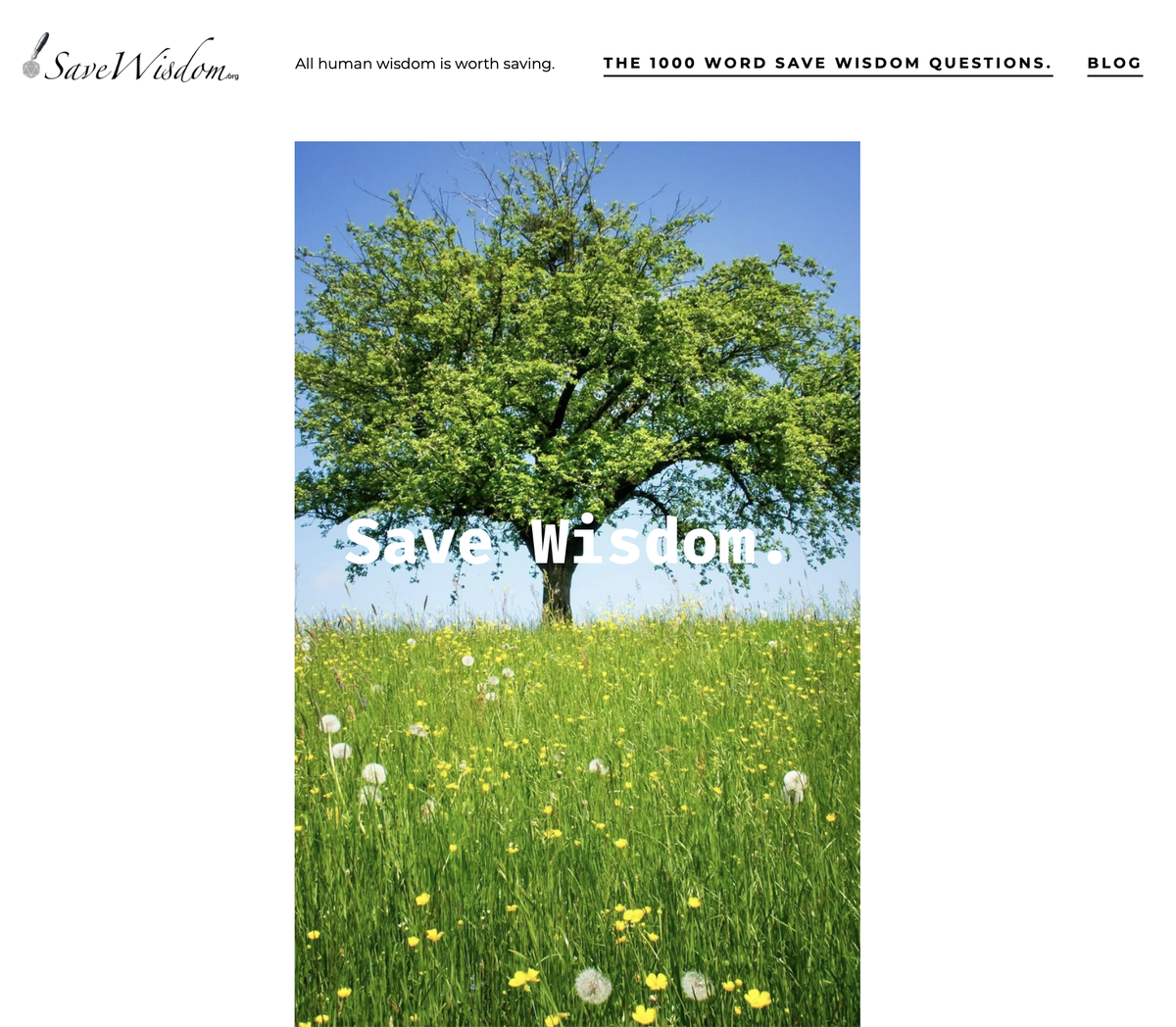Teaching & Learning Page:

Web Pages:
https://www.quantamagazine.org/the-unraveling-of-space-time-20240925/
https://www.futuretimeline.net/
https://1001albumsgenerator.com/
1000 Questions To Save Wisdom
SaveWisdom.org is a project dedicated to preserving individual wisdom. The website has 1000 questions designed to interview someone about their early life, formative experiences, values, perspectives, and challenges. These questions are intended to invite deep reflections and greater self-understanding. They are open-sourced and can be used freely for personal use.
They could be used to interview an elderly relative - perhaps on the occasion of their birthday - to gift to extended family.
Techie Tips:
Vehicle Motion Cues
If you have ever felt queasy while using your iPhone as a passenger in the car of your friend who has Dominic Toretto-type driving skills, iOS 18 has a nifty feature that might help.
This new feature is called Vehicle Motion Cues, and it is designed to reduce motion sickness by adding subtle, animated dots along the edges of your screen that mimic the vehicle's movement.
These dots help your brain better align with what’s happening in the real world without interrupting your scrolling through Instagram. You can enable this feature by going to Settings → Accessibility → Motion and choosing ‘Show Vehicle Motion Cues.’
You can also set the option to ‘Automatic’ to ensure the cues only appear when your iPhone detects you are in motion. If you want to control it manually, add the Vehicle Motion Cues shortcut to the control center and toggle it on or off as needed.
It is a thoughtful feature for anyone (like me) who struggles with motion discomfort, but of course, it is not something you should use while driving.
Awesome Apple TV TV Streamer:
This small box makes it insanely easy to transfer all streaming accounts to with your iPhone, which you can also use as a remote. It easily pairs with Airpods for private sound.
The best thing is how Siri is incorporated. You can ask, “What did they say?” while watching a video, and it will back up and repeat the last bit of dialogue. Or you can audibly ask it to run “For All Mankind”, and it will search and find it among all the streams you have subscribed to. No typing to find out where a particular show can be watched. That alone is worth the price of admission, but there are a lot of other cool smart features as well, like displaying photos from your phone.
Verbatim Search Results
If you're finding that using quotation marks no longer returns exact phrase matches on Google, here's a workaround: After conducting your search, click on "Tools" under the search bar, then click on “All Results” and choose “Verbatim”. This will display search results that match the exact phrase you entered.
Chat GPT Prompt Guide:
One of my favourite types of writing prompts uses a multi-step process. Here's a quick way to have any tool edit itself in a single prompt with a step-by-step list.
Today’s Prompt:
Write, rewrite, edit, then rewrite again.
Step 1:
Compose a 200-word article discussing the importance of creating detailed prompts when interacting with AI. The article should highlight the differences between human communication, which often includes implicit context, and the explicit context that AI systems require to operate effectively.
Step 2:
After completing the article, revise it to make it more direct, succinct, and focused. The aim is to streamline the content while retaining its core message.
Step 3:
Act as an editor and look through the revised output from Step 2. Make suggestions of sentences, phrases, and wording that could be edited to make the piece say something impactful that evokes emotion
Step 4:
Rewrite the output from Step 2 based on the editor notes from Step 3.
Why we like this prompt:
1. Clear Step-by-Step Structure:
Each step is clearly numbered and logically
sequenced. This structure informs the model to take on one task at a time.
2. Requirements for Each Step:
It specifies distinct goals for each step: composition
(Step 1), conciseness
(Step 2), editorial review
(Step 3), and rewriting
(Step 4). This makes it clear what is expected and prevents ambiguity.
3. Iterative Refinement :
By setting up an iterative review and rewrite process, it works in multiple steps to create a polished piece of writing.
Result:
Step 4:
Final Rewrite
Detailed prompts are essential in making Al truly work for us. While people can read between the lines, Al lacks intuition. It doesn't pick up on tone, shared context, or subtle hints; it needs clear, structured information to deliver useful responses. Vague prompts leave Al guessing, often leading to responses that fall flat, missing the mark entirely. When we provide clear and specific instructions, though, we guide Al in understanding our intentions more fully, creating a smoother, more helpful interaction. A well-crafted prompt allows us to respond in ways that feel relevant and aligned with our needs, moving beyond robotic replies to something that resonates with us. By embracing the power of clarity in our prompts, we unlock a more intuitive, responsive Al experience- one that feels less like a tool and more like a collaborator. As Al continues to become part of our lives, knowing how to communicate with it effectively will be key to making the most of its capabilities.
Sketchplanations:
The fight-or-flight response is our body's automatic and ancient response to perceived threats or danger. This innate physiological response in animals and humans prepares us to either confront a threat (fight) or flee from it (flight).
Face to face with a tiger
At the annual Wildlife Photographer of the Year Awards, I saw an astonishing photo of a tiger surprising workers in a field (Tiger Run by Nejib Ahmed). Everyone is in flight mode, but one man has stood to fight, staring down the approaching tiger with a long stick. The photo is captivating in its drama and struck me as a perfect fight-or-flight example in action. Thankfully, no one—including the tiger—was hurt in this instance.
The adrenalin that can flood our bodies during such moments may sometimes give us strength to do what we didn't expect, surprising ourselves with what we are capable of—Nicola Morgan, when discussing the amazing teenage brain, gives an example of her leaping a 5ft fence and looking back with amazement.
Reptilian brain, Lizard brain
The fight-or-flight response is linked to theories about how different parts of the brain developed during our evolution. Modern research has corrected some aspects of this idea, but the basic concept remains.
The most primitive parts of the brain—those we may share with, say, dinosaurs—are responsible for automatic behaviours like protecting territory, aggression, fear and fending off danger. This is often referred to as the reptilian brain or lizard brain. These brain areas are key to our survival instincts and play a critical role in activating fight-or-flight mode.
Years of evolution since then have given us brain structures like the limbic system, which is responsible for our emotions and social behaviours. The amygdala, part of the limbic system, is especially important in triggering fear and the fight-or-flight response.
Later, the neocortex evolved, enabling humans to assess threats rationally, solve problems, and make decisions—giving us more control over how we respond to fear or anxiety.
The fight-or-flight response, also illustrated by the snake rearing up in the sketch, is a fallback to our oldest instincts from the oldest parts of our brain when faced with a threat, so the theory goes.
Freeze, Flight, Fight, Fright
Fight-or-flight, coined by physiologist Walter Cannon in 1915, is only part of a broader spectrum of acute stress responses. A more accurate sequence we experience may be freeze, flight, fight, or fright.
Freeze:
Our immediate reaction to danger might be to "stop, look, listen," remaining hyper-vigilant while we assess the threat and perhaps hope by not moving, the dinosaur won't spot us.
Flight:
We may flee the situation to safety.
Fight:
If escape isn't possible, we might fight back, as shown by the brave individual in the tiger photo.
Fright:
This might include panic and immobility, playing dead in the hope a predator decides we're not worth eating after all.
As you see, the updated list continues with excellent alliteration, which no doubt helped make the idea sticky in the first place (other proposals add fawn, faint, flock and more).
When Fight-or-Flight Doesn't Help
While the tiger scenario shows our ancient brain instincts at work, most modern-day situations don't involve life-or-death threats. However, we may still enter fight-or-flight mode during stressful, anxiety-inducing moments, such as public speaking, a challenging work interaction, or a difficult conversation.
In these cases, the fight-or-flight response may not serve us well. The same ancient brain that would help us survive a predator may now cause us to avoid daunting tasks. Whether it's a work presentation, a cold sales call, or confronting a personal issue, we may feel the urge to retreat from the action and get a snack from the kitchen instead.
When our ancient instincts—so finely tuned for survival—no longer serve us in modern situations, it's helpful to pause and let our higher-order thinking take the lead. Techniques like box breathing or meditation help calm the body and mind, allowing us to move beyond fear and resistance. By doing so, we can overcome the automatic urge to "fight or flight," or even freeze or fright, and instead respond with clarity, control, and confidence.
Isometric projection is a simple way to draw 3D shapes. The meaning of isometric is "equal measure," from the Greek words iso- for equal and metric for measure. So, in an isometric drawing, all three axes, x, y, and z, are scaled equally, giving a clear, undistorted view of an object in three dimensions.
Except that isometric drawings can look a little odd and oversimplified. This is because of the lack of perspective, a visual distortion of 3D shapes we experience in the real world. In a perspective drawing, parallel lines converge in the distance towards a vanishing point, but in an isometric drawing, parallel lines stay parallel, and sizes don't get smaller in the distance.
The lack of perspective in an isometric view can make it look artificial, but it always looks clear.
I learned isometric drawing when studying engineering. Armed with a stack of isometric paper with a printed isometric grid, we had to reel off exercises involving drawing isometric views of 3D objects. And isometric projection is really handy for this. It can take a long time to build the skills to sketch a realistic 3D-looking object, perspective and all, but with isometric paper, you can quite quickly produce something that communicates to you or others what's in your head or on the workbench.
Isometric projection is handy for boxy shapes—I chose an approximation of the Bauhaus Dessau building by Walter Gropius to show it. If you need curves and angles, just like with perspective drawings, it can help to draw more boxes around these areas and use them to align your curves and meeting points for your lines.
Isometric views and their variations have had somewhat of a resurgence of late in video and board games. It turns out they're pretty helpful in map-based or city-building games such as Zynga's Farmville, Civilisation, or Sim City as the isometric view allows all parts of a scene to be viewed equally—in the distance or up close—while still seeing every detail in, say, a building, wherever it is.
Just as in the drawing here, sometimes shapes drawn in isometric view lend themselves to curious optical effects. The lack of perspective can make the difference between heights and depths ambiguous. So, you can't always tell if two surfaces are at very different heights or if one is in the distance. The brilliant puzzle game Monument Valley uses this quirk of isometric projection to create mind-bending puzzles that are well worth a try. For instance, rotating a high surface can suddenly make a platform that extends far into the distance 🤯.
Isometric-like projection can also help make impossible shapes, such as the Impossible Staircase, or Penrose stairs. Another type of projection, anamorphosis, creates a drawing that only looks correct from a particular viewpoint. Anamorphosis leads to some remarkable street art.
Article
How Are the World’s Trees Doing? A New Assessment Has Answers.
They play an essential role in supporting life on Earth, but many species are in decline, researchers found.
A section of the Sycan Marsh Preserve, a wetland in Oregon, home to thousands of birds and endangered fish, after a wildfire in 2021.
Credit - Chona Kasinger for The New York Times
More than a third of the world’s tree species are threatened with extinction, according to the first comprehensive assessment of trees by the world’s leading scientific authority on the status of species.
The findings, announced recently by the International Union for Conservation of Nature Red List, are especially sobering given the amount of life that trees sustain. Countless species of other plants, animals and fungi rely on forest ecosystems. Trees are also fundamental to regulating water, nutrients and planet-warming carbon.
“Trees are essential to support life on Earth through their vital role in ecosystems, and millions of people depend on them for their lives and livelihoods,” Grethel Aguilar, director general of the International Union for Conservation of Nature, said in a statement.
The tree assessment is considered comprehensive because it includes more than 80 percent of known tree species. In all, 38 percent were found to be at risk of extinction. More than a thousand experts from around the world contributed.
Island biodiversity is particularly vulnerable, in part because those species often have small populations that exist nowhere else, and island trees accounted for the highest proportion of trees threatened with extinction. In Madagascar, for example, numerous species of rosewoods and ebonies are threatened. In Borneo, 99 species in the family of trees called Dipterocarpaceae are imperilled. Fewer than 75 mature individuals of the red-flowered Harpalyce macrocarpa, known in Spanish as maiden’s blood, remain in Cuba.
Around the world, the biggest threats to trees are agriculture and logging, followed by urbanization, said Emily Beech, head of conservation prioritization at Botanic Gardens Conservation International, a nonprofit group that led the research now included in the Red List.
For temperate regions, pests and diseases are a major threat to trees. Climate change is an emerging threat, Ms. Beech said, and it’s unclear how warming will affect the majority of tree species.
The group announced the findings in Cali, Colombia, where government representatives and other participants from countries around the world have gathered for the United Nations biodiversity conference, which is held every two years. Now in their second week, the negotiations are bogged down in tensions over how countries that are poorer economically but often wealthier in biodiversity are going to pay to conserve and restore nature instead of extracting resources.
Deforestation is devastating for the climate and biodiversity, but the world has struggled to stop it. In 2021, more than 140 countries, including Brazil, China, Russia and the United States, vowed to end deforestation by 2030. So many countries signed on that the agreement covers some 90 per cent of the world’s forests.
In terms of action, though, “the news is fairly bleak,” said Erin D. Matson, a senior consultant at Climate Focus, a company that leads an annual assessment of progress toward global forest goals. It found that in 2023, the global deforestation rate was 45 per cent higher than it should have been to be on track to halt deforestation by 2030.
“There is a huge blind spot in terms of understanding and prioritising the value of standing forests,” Ms Matson said. “Governments are often affected just as much by profit motive as private companies, and it’s much easier to make money by clearing a forest or harvesting timber from a forest than by protecting and conserving a forest.”
Still, Brazil has shown that it is possible to curb deforestation with political will and strong enforcement. Now, it’s proposing a new fund that would pay developing countries to maintain their forests.
The Red List also announced that the Western European hedgehog, until now considered a species of least conservation concern, has deteriorated to the “near threatened” category. Agricultural intensification, roads and urban development are driving the declines, scientists say.
Catrin Einhorn covers biodiversity, climate and the environment for The Times.












